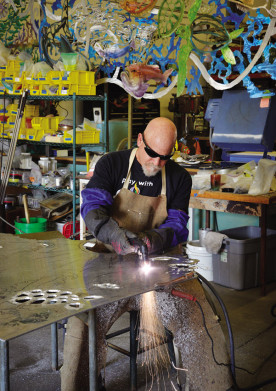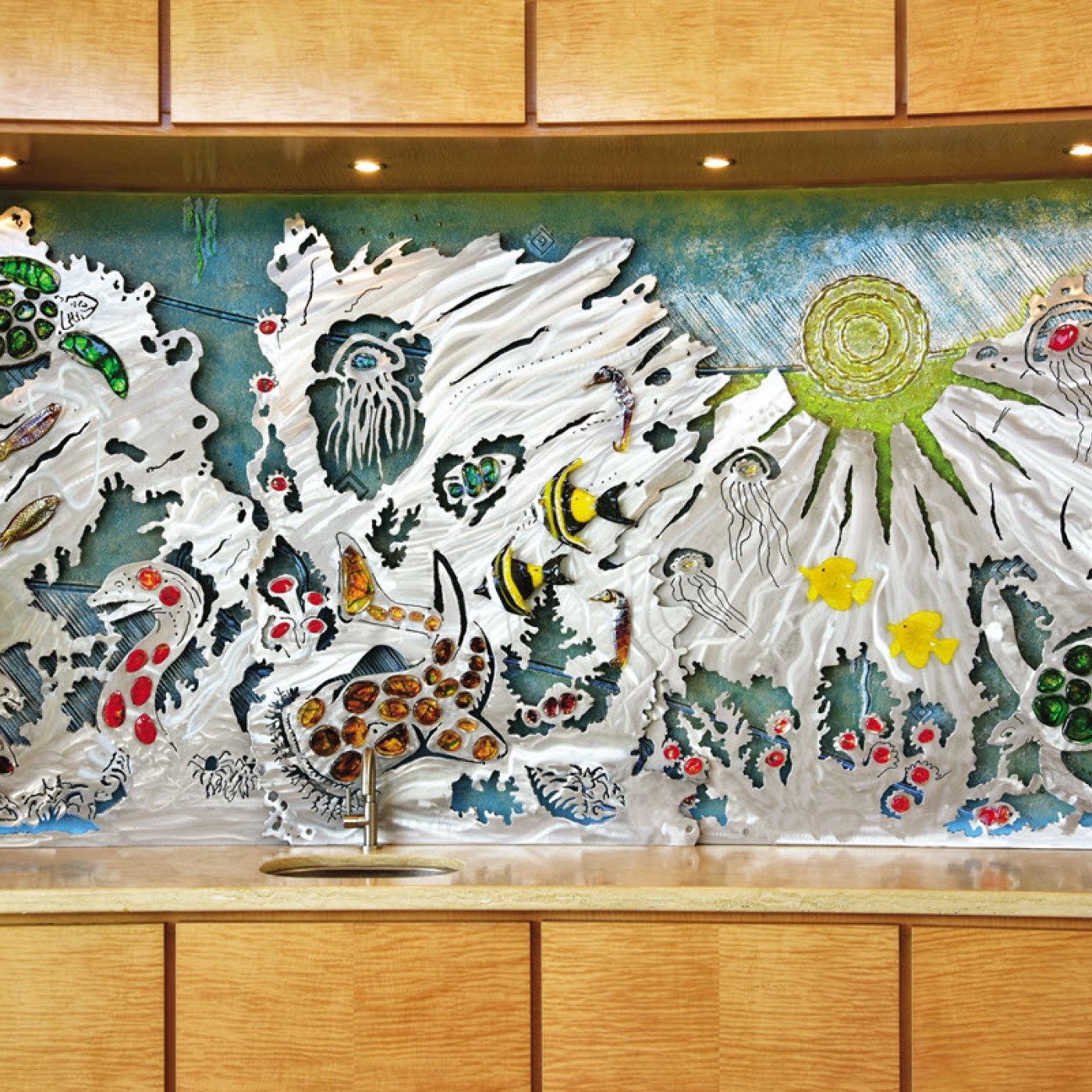Do You Have a Safety Net? Protect Yourself From Fires, Floods, and Hurricanes
Insurance for artists is a safeguard against disasters, both natural and human-made, but it is something artists often neglect to consider.
Why do those who insure their cars, homes, and lives hesitate to insure their art? A changing climate, upsurge in fires and floods, and increase in tornadoes and hurricanes in the Midwest and Florida, respectively, make it a topic worth reconsidering.
In fact, more artists are choosing to carry insurance on their art, tents, and trailers. The 15 festival artists who were recently asked whether they carry insurance against damage or theft, per show or annually, said they do.
Many artists who work from home rely on their homeowners insurance to cover them. Some who work in brick-and-mortar galleries or studios outside their homes carry business liability insurance, as mortgages and business loans require it. But these same artists might not carry insurance while on the road.
Kentucky folk art sculpture artist Carnie Jean Weeks has used many found objects in her work to make angels, folk people, and various animals. Today, she collects Social Security as her main source of income and rarely creates much art for sale.
“I don’t have gallery representation since COVID-19 (2020), and I don’t like to run around and do festivals. I don’t take credit cards. So, if someone happens by my house or cabin and they’re interested, I’ll sell for cash,” Weeks said. “So, no, I don’t have insurance. I have retirement. I have homeowners insurance. I still love to create, though.”
However, this is not the case for most who are still selling their art — regardless of pensions or Social Security — or for new artists on the scene. Should they place themselves in a liability situation if a disaster occurs?
Put Safeguards in Place
Most homeowners insurance policies do not cover damages to artwork in progress or bodies of artwork. It is a misconception that an inventory will be covered in the instance of natural disasters or theft.
As a whole, homeowners policies are not specific enough to cover what artists do. Their primary focus is the home, with the personal contents aggregated into one big category called “personal property.” And that lump sum does not usually add up to all the hours of labor artists put into their work, let alone the value of the work itself.
An artist’s day-to-day living is also piled in there, like their favorite recliner or laptop computer. Once all their bits and pieces are replaced so they can resume a normal life, there is not much left over to replace days, weeks, or years of inventory. Not having insurance that covers personal property, let alone art, can be a serious issue.
Insurance companies not specifically targeted to cover work and supplies have a limit as to how much is covered under any blanket personal property claim. People’s Trust Insurance in Deerfield Beach, Florida, has a standard personal property policy. It only covers collected fine art, such as paintings and sculptures, and requires appraisals prior to coverage. “Florida is a hard state to obtain insurance in now due to all the incidences of hurricane damage in the past couple of years,” said Representative Daniel Brown. “We just don’t include art inventory as part of losses.”
The Benefits of Specialized Coverage
The only way to insure against the loss of work is to find an insurance company that offers the highest possible personal property coverage. Artists pay a much higher price for this under any homeowners insurance.
Most homeowners insurance companies require a totally separate policy for floods, which are a real threat during or after a hurricane or severe storm due to surges and flash flooding. Artists who want blanket coverage for their art need insurance meant to do just that.
The most popular insurance company for the trade is ACT (Artists, Crafters, and Tradesmen) Insurance. It is a general blanket policy, with liability limits one can live with. Its cost (for sales of up to or less than $50,000 annually) is $279 for a year’s worth of coverage.
In addition to inventory on hand and any works in progress, the policy covers studios, tools, equipment, and supplies, as well as work used in teaching engagements, art demonstrations, or hosted training sessions.
It is affordable, comprehensive insurance geared toward artists. There is also a “show policy” that is $49 for one to three consecutive days. Coverage for up to 90 days is available for an increased price.
For those who travel a circuit over a three-month period, this may be the ticket to covering any damages incurred. The policy covers an artist’s work and equipment, as well as damage to any rented equipment (but it does not cover any personal injury). A thorough reading of exclusions (especially the venue exclusions) is wise. Visit www.actinsurance.com for more information.
Insurance for Artists (Zinc) is another option for artists and crafters. According to its website, “The policy extends liability insurance at your home or studio premises and at exhibition sites.”
It also provides full liability coverage for items previously sold. The business property portion of the policy covers equipment, supplies, and finished work.
Exclusions include wear or tear or gradual deterioration, unexplained disappearance of inventory, or “shortage due to employee dishonesty.” Since most — if not all — artists do not have employees, they can slide on that one.
The company offers deductibles of $500 to $2,500, depending on the choice of coverage levels, and covers the 48 mainland states (not Hawaii or Alaska). The “Master Policy” coverage costs $435 and consists of business liability, business property (while in one’s possession), and transit and exhibition.
The coverage year begins on Oct. 1 of any year, runs through the following Oct. 1, and requires annual reenrollment (no auto-renewal). Visit insuranceforartists.com for more information and its contact form.
Make sure any policy covers damages and loss due to earthquakes and water damage, as well as windstorms. Those are major reasons artists lose work and businesses, with fire being the primary cause. One important note is that this insurance does not cover an artist’s building, just the contents. It also does not provide for loss of business income or a business vehicle.
Let’s Talk About Safety Nets
CERF+ (Craft Emergency Relief Fund) bills itself as a “safety net” for artists, and rightly so. While not related to insurance, which artists should have, it is a strong support network in both financial and emotional aspects if damage is incurred before insurance is secured.
It was co-founded as a grassroots organization in 1985 by Carol Sedestrom Ross (then president of American Craft Enterprises) and glassblower Josh Simpson. They decided to create an organization that would provide assistance in a more expansive way to artists in dire circumstances beyond their control.
CERF+ has provided more than $2 million in emergency funding and other financial resources to those in need and more than $400,000 in donated services to help safeguard artists’ livelihoods nationwide. The nonprofit has since expanded into providing educational resources and programs, extensive (and global) networking, advice about taxes and preparation, insurance suggestions, and more.
CERF+ is an invaluable resource for information. Artists must apply for financial help. So many artists need it after a disaster that they may not receive funding for replacement materials, etc.
Most of the received donations are from fellow artists who support the organization. There are multiple stories on the organization’s website about artists and crafters who sought assistance, either through grants or loans, and how CERF+ stepped up to the plate and delivered. In fact, “100% of grantees cited CERF+ assistance as a contributing factor to their financial recovery after an emergency.”
An Artist Who Rose From the Ashes

In 2017, James Stone saw his joint business, Stone & Glass in Escondido, California, devastated due to an electrical fire. He faced overwhelming emotional and financial decisions, including whether to reestablish the business elsewhere or quit it entirely.
Stone believes communication was a key factor in not only getting his own insurance company to recognize the seriousness of their claim but also getting CERF+ to step in and provide immediate financial assistance so the husband-and-wife team could step back and breathe a little — enough so decisions could be made rationally during a time when a fight-or-flight reflex kicked in.
He eventually received assistance through one of the senior adjusters to go through each line item with a fine-toothed comb to try and get them the replacement costs to rebuild. “Understanding your policy is of the utmost importance, so that you can get as much coverage as possible. Ultimately, we received about 70% of what we needed to find a new location, salvage what we could, and reopen our business within a year,” he said.
Stone and his wife came through their nightmare and rose from the ashes. “I have always valued my supporters and patrons. But the fire and its aftermath have really driven home the importance of community,” Stone said.
He said having the right insurance and the right relationship with the insurance adjuster can mean everything when disaster strikes. “Having the right team around you is of paramount importance,” he said, and that included not only his support from patrons and friends but also organizations like CERF+.

Glass mosaic artist LeAnn Christian carries ACT Insurance and has for years. She said it is “necessary, because you never know when it will be important to have, like if someone backs into your trailer and destroys the art, and it’s mandatory for some shows that I do anyway.”
Christian experienced severe flooding due to Hurricane Ian. Her homeowners insurance is in remediation for mold issues in the walls and ceilings.
She works out of a studio inside her home and did not lose much inventory or product because she packed up most of her supplies in bins prior to the flooding. “ACT might not need to cover anything, but I will read (the policy) and see,” Christian said.
Christian previously carried RLI Insurance as her business insurance, but it was not specifically targeted to full-time artists. She is considering the purchase of a shed to put on her property as a separate studio, which would mean everything would be covered by ACT Insurance, not homeowners insurance. During remediation, she still must work because she has festival dates approaching, as well as wholesale orders.
With all the uncertainty due to weather issues, insurance for an art business is a good investment. An artist myself, I personally sign up for ACT Insurance every year, although the $300 hit always makes me think and rethink if I really need it.
One year, before I bought insurance and in my early days of working festivals full time, I attended a show where my tent space was inadvertently marked out on the grass to include a sprinkler head that was not visible. You can guess the scenario.
The sprinklers were automated to go on in the early morning, and most of the tents on that side of the setup got wet but not inside. Mine did.
I lost several pieces of art and a lovely driftwood table I made for my booth. I have carried insurance ever since and recommend other artists do the same.
